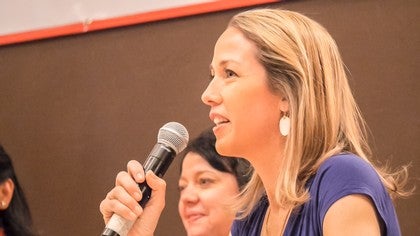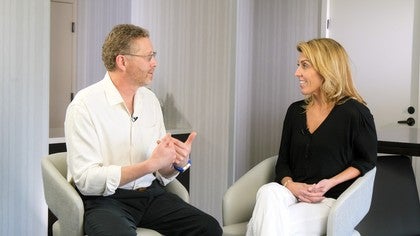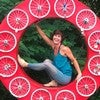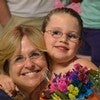Description
On the panel are Amy Taylor Alpers and Brett Howard representing Romana Kryzanowska, Michele Larsson representing Eve Gentry, Jillian Hessel who was trained by Kathy Grant, Carola Trier, and Ron Fletcher, Deborah Lessen representing Carola Trier, Blossom Leilani Crawford and Cara Reeser representing Kathy Grant, and Kyria Sabin and Diane Severino representing Ron Fletcher. This is truly a special discussion that you wont want to miss.
It is with sincere gratitude we thank Kyria Sabin and the entire Fletcher organization for allowing us to be a part of this important event.
About This Video
Transcript
Read Full Transcript
Chapter 1
The Legacy that Was Passed Down from Joe to the Elders to the Panelists
[inaudible].
What were your main takeaways from her?
And when I worked with Romana at the end of my session, I was so out of breath, I was like, oh, because she worked so hard and had to go back into the dressing room. And I was like shaking because it's such a workout. But when I also worked with her, I did come to her with a knee issue. I also had a dislocated shoulder at one point, and she rehabbed me. So, um, I think it was really treating the individual in front of you and improving their quality of life. Um, what, um, were mine main take away is I would have to say is, um, to care and to have empathy. Um, so I still teach quite often. I do about 40 hours a week, a week with my regular clients, but I also do teacher training and, um, she taught me you have to care and you have to put yourself in somebody else's shoes. And for an instructor having a client, you know, I really need to look at the body, address it, listen to what it's telling me, and then best meet that client's needs and nurture them and make them feel successful. A plot is really, it's about creating success and uh, she really nurtured that a lot. Um, and then also just having empathy, empathy with my students, knowing that everyone's a different learner and not everyone's going to learn maybe the way I learn and not all of my, uh, apprentices or my, uh, clients are going to learn the way I am. So I, you know, really meeting them where they are, um, and creating a success for them. So that's what I would say. I'm going to hand it to Kara. Same question. Repeat it.
Absolutely. That question is, what do you think were the main takeaways that Kathy, uh, took away from her experience at Joseph [inaudible] studio? And then the second part is, what were your main takeaways from Kathy?
Hmm. And then another day he taught her how to walk, imagining that she was pulling an elastic band with her heels. She had had a knee injury. So I think her takeaway, she said to me many times, I knew he was a healer and she wanted to dance again. And so she went back over and over and over again. And indeed he was a healer.
And indeed he healed her and he gave her courage and confidence and strength to be a dancer again. And um, so I think her main takeaways were to, to understand the power of aligning and centering, visualizing, um, trusting, um, and, and coming back into her body again after, uh, a scary and life changing injury. And, um, really my takeaway is identical. I came to her very injured, very frightened and not dancing. And, um, she, you know, Cathy, um, her interests for me right away were to have me let go of the tension that I was holding from my fear and my pain. And once she got me there, which took a long time, um, she then rebuilt me and had me believe again. So again, it was confidence.
It was letting go and it was, um, centering, aligning and, um, really what she said all the time is yes, you can. Yes, you can. Yes, you can.
And it was Klara who taught her how to use the method and the equipment for her at four 11 and 90 pounds.
And I just want to quote her since we have her words. This is a children's book that was published in 1982 called exercise. What it is, what it does. And the introduction says you play ball, jump run, go to gym, ride your bicycle, you go to dancing class, why should you exercise as well? The answer is to do all these things better.
And so what she taught all the clients was, if you're a dancer, you have to go to class every day. You have to go to rehearsal, but you must do your exercise. And it was the same no matter what age you were, no matter what your lifestyle was. And um, this, this was the general understanding that you have to exercise. It will make you feel better. It will make you happier. And the definition of control really was very apparent that the sound mind and the fit body are one. And if one one of those two was off, you don't achieve full health. Um, so what I took away from Corolla definitely was that, um, but also because of her background and the teacher that she became, I was definitely on a quest to seek more science background to match instinct in teaching. Um, both of those things are very important and I know that I am instinctive to begin with. And so I needed to explore that other side. Um, and, and also to keep in partying, the philosophy. And, uh, I just want to say that I never read, returned to life until years after I stopped working for Corolla.
And when I read it, I felt I knew it all because it was in her teaching.
And, um, and then when he rolled down on the machine, one of the first things Joe said, are you straight? And, um, I laugh when rod says that because, you know, there's this wonderful pregnant pause and, and, um, and Ron said, well, I think so. And, and show Joe said, well, you're not. And he wasn't. Um, but it was the whole idea of getting the body into correct alignment before you initiate the movement, really understanding where you are, um, attaching the mind to the work. Um, and the other story that I love about, um, Joe, I mean, there were so many stories that, that Ron told about chow, but, um, the other one was when someone would ask, you know, what is this movement about? And wanting to know what muscles were involved. And you know, clinically, you know, what, what was the movement about? And Joe would say, it's for the body, it's for the body. And, and I'd love that. It's, it's, it's, it's whole body movement. It's whatever was saying. It's not about parts. It's, I'm, and he never ever addressed the knee. Um, the other thing that, that Ron learned from Cho, although Joe never really explained it, is the importance of the breath. So although Joe Roach with some articulation or, or, or, um, and, and return to life about the breath, um, in the studio, the only two things that, that run heard was you must breeze. And she busted out the air to in the air.
So he knew that the breath was important, but he said that show never talked about when to breathe, how to breathe, why to breathe. And, and he felt that it was because he didn't have a command of the English language. And so Ron took away that he, that the breath was really important. But he went, when he opened his studio in Los Angeles, he spent the time to, to speak to pulmonologists to, to find out more about the breath. And so he developed his breath technique and it came very much from that. My takeaways. Um, so sorry. Um, one of my takeaways is just the, um, gratitude, gratitude for being in this body of gratitude for what Ron called the divine mechanism. And then the other takeaway was much once more, Ron was never satisfied. And, um, it's that, it's that, um, wanting to get a little bit more out of the piece, wanting to work a little bit more with the individuals. So, and, and I love that. That's what this work is about.
Chapter 2
How Each Elder's Background Contributed to the Legacy of Pilates
Second question is, how do you think, and let me say, I'm going to start with you, Diane. Uh, how do you think your teacher's personal and or professional background contributed to the legacy of the polarities method? So how did Ron his background personally and professionally contribute esteemed colleagues? [inaudible] and I do mean that sincerely. What a pleasure and an honor. Uh, well, Ron's background I think is well known. Coming from the Martha Graham School of Dance, which he got to add quite an old age for a dancer in his twenties. So we had a fully formed mind when he went in.
She completely transformed him into thinking like a dancer. He wanted to take and transform it onto more bodies when he got to his studio because he had the truth, he had to plot his truth and he had Martha's truth. He had truth in movement. He knew the sprain was important. Martha talked about the brain being integral. I mean it's there, the brain starts the movement, not the other way around. And from there he parlayed it from his mother experience to becoming a really good choreographer. He did a lot of commercial work on Broadway.
They egus the ice capades he had a rhythm. He knew how to work bodies. If you can go from an ice skater to a modern dancer, to a gymnast, he knew how to relate to everybody. When the studio opened, he had all of that. He was fully, fully aware, had the plot. He's experienced to bring in all the wonderful work that Joe did on his body. The Martha experience, the sense of rhythm from his choreographic experiences, how he was able to bring that into the breath pattern. When he spoke of flow, he tried to get that across to just beginners. They got it. He was able to communicate that. Now you can't do all that without the mind, the breath and spirit. I will also add for me, you can do mind, breath and spirit without the passion.
You don't work in politeness for money. You do it because your tip is, oh my God, my knee feels better. My shoulders is moving. That's the tip. We all get moron and viewed that. You know, he was enthusiastic. He made everybody move like a dancer. They didn't know they were moving like a dancer, but when they left the studio a, he made beautiful bodies. It was all about that. You gotta see it, you've got to see it. Did he want more? You bet you could pull up another inch.
You can lengthen out to the back of that neck passion. Right. Flotsam why don't you take the next, yeah, it's a funny question because to me,
So she's working in nightclubs cause she just loves to move. And then she gets a on Broadway and then she becomes an arts administrator. Like the woman did everything like balls out. And that's really also how she taught. How she and how and and how that contributed to the method is, is that if you are in the studio with her, she gave you everything.
And
And then she walked down the hall and saw Eve's class and went, oh look, there's someone doing the same thing. And for her, that discovery, it was all, that was what this was about for her. Um, and I think that's how she, her personal professional life, she, there's no line. It was all, and it was all about the work. I had a conversation with her husband recently and he said, you know, the thing about Kathy was she was just all about the work. She really, I mean, we tried to make her money, we tried to make your money and she, um, how Harrison who would say, you know, she just walked right by that bag of money every time. And it's true. She really just cared about doing good work and not even like she loved coming here and being kind of famous. She did, she'd be like, oh, honey, wasn't that fun? And then we'd get on this, I'd be like, oh, we're back again. But it was really about like in the studio trying to figure out that thing that, what is it now? And I think that kind of excitement that we all experience with her lives on.
And I'm done.
You know, unlike most of the other original elders who were more choreographers and modern dancers in out in the world and a little more theatrical and creative in their own art. Um, she really, I think considered herself kind of just the direct purveyor, like the muse. Nothing Muse actually, I wouldn't say, but the, the, the person who was to take this form that somebody else created and continue it on and not actually become a creator of something else. So I think as a classical dancer, and that's what helped my sister and I have always felt too, that's I think one of the reasons we were so attracted to it because we actually love form and we're not as interested in creating our own form, but rather in kind of going deeper and deeper and deeper within a farm. And I think, you know, when, when you're more classically trained and you're not necessarily intending to go out and become your own choreographer, you're inclined to kind of stay within the boundaries a little bit. But there's, there's no doubt at all that her ballet infiltrated, you know, she, she definitely was a frustrated ballet teacher and very much you see the influence of that come through loud and clear and louder and clearer as years go by. I think it's just having watched Brett's workshop today, I was like, oh yeah, that's even way more than 20 years before that time. So, you know, I think she got very, very excited to have amazing bodies to work with and very thrilled to also get to be put on a pedestal and given, you know, a larger stage to do that in that pulled forth a little bit more of her creativity. But as everybody has said, I think that's exactly what we got as well, was that there was this incredible form designed by genius. I didn't consider myself a genius, but I felt like there was, you know, a lifetime plus worth of material to explore here without having to create anything new myself and actually be able to kind of bring forth just my, my unique vision, but not my unique choreography, you know? And so I think that's, that's really the, the loudest lesson I think I got from her, but it was also just so in tune with who I was anyway, that it was a natural and natural evolution to have that happen.
Um, Debra, uh, Corolla was also an [inaudible]
She went to all their follow up appointments. And so I would say two thirds of the clients at her studio were referred by orthopedists. So I innocently thought, okay, this is what all polities teachers do. We had to be able to handle a huge range of problems and with direct contact with the clients, doctors. So, um, that was an ideal learning situation and I think that it has been perpetuated, um, in different ways in the Palazzos world now. And hopefully we'll continue to grow because we need to have a marriage between wellness and medicine.
Her main contribution probably was the fact that she started doing all those little, what we sort of nicknamed [inaudible] stuff because she was more comfortable moving in space without weight, you know, without springs. She said that Joe [inaudible] unders, he had developed that equipment. He understood instinctively exactly what the springs would do to the body at any one point. She, when she got anybody that was injured didn't put them into Pele's right away she did pre [inaudible]
Chapter 3
What Should Be Preserved to Maintain the Integrity of the Pilates Method
We'll go to blossom to Jillian, to Amy again to Michelle and to Diane. Um, and this question is, in your opinion, what must be preserved in order to maintain the integrity of the plotters method today? And I will begin with Jillian Hessel. Well, last but not least, I think, um, oh my gosh. Well everyone has to understand that I'm a complete hybrid of every everyone else who's been sitting up here. I've had such an extraordinary and unique opportunity, um, to me, not only in my dance career, George Balanchine and Martha Graham, but then to become injured, be referred by a fellow dancer first to Kathy grant who saved my life and then being an out of work dancer and needing to move. I'm summing up what everyone has said so far.
I think I was referred to teach to learn to teach at Corolla tree and had the rare opportunity to train, to teach with Corolla simultaneously with working on my personal broken body with Kathy. What are unique things? So talk about I, I'm probably completely off the point, but this is what I wanted to say. After listening to everyone else that experience, that experience should be saved to present. I think that what should be saved is what everyone is talked about, the summary, what I am, which is the best of everybody. You know, I've had the opportunity then to after studying with those ladies, moved to La and, and be inspired once again by Ron who reconnected me with my dance and the groundwork that, that Diane spoke of. And I think that all of us together are stronger and better. And my colleagues, I'm so impressed to be sitting here with you, whatever it said about the medical community coming together and needing to communicate. We have so many boundaries. The heroes in action, when is that they're doing a presentation. Um, the work that yes, here's in, in motion the amputees that have come home from the wars and my God in Boston had their limbs blown off. You know, and there's already been this incredible outreach, by the way, bringing in Christy, the Internet is the way of the future and people were coming online about 24 hours, I think after the Boston marathon when people lost their limbs and connecting the heroes in motion is yours in motion idea of um, helping, helping people become, as Brett said, better. And as you said, why do we do it to get better at everything we do?
So there's so many different niches now that we can all choose to go into and I'll be talking about that tomorrow in Discovery, your own teaching style. Because I really do feel I've, I've gotten the best from everyone. You know, I had the opportunity to meet eve and Romana and it's all true. Very good. Thank you. And let me hand it back over to blossom please.
And once I said thread the needle and she went, oh, no, no, no, no honey, it's eve gentry's thread the needle. And I was like, all right. And I mean literally there was a script and if I did not say eve gentry's thread the needle, she would get up in arms. And I think to me that's really important. And so in my mind it's, that's what I think is important. But then I know that there's a whole, so the second answer is, I know there's a bunch of people who do plays that don't give a poop, you know, that I'm going to say that would be a swear word normally, but they don't, they don't care. And who am I to say that, that, that plot is, isn't as great because they don't know who their elders are. So I think the second part of my answer is,
Really just try your best. I think. I think back to when, uh, when I was a young teacher and I said to Kathy, well, how do you know that they're crooked? How can you tell? And she was like, honey, it's like a driver's license. Just because you know, you, you can teach [inaudible] do you really like when you learned, when you got your driver's license, did you really know how to drive? You know, like, and so I think just, I think of like just, and she's, you know, just do your best. And I think if we just come with that sort of attitude, that's really sort of the core of the integrity of the work is just are you doing a good job and trying your best. And also, I think kind of back to what Brad said, like really teaching the person in front of you. I remember once I had this person, I said, Kathy, I don't know if I know what I'm dealing with her. And she said, I think you should tell her. So I literally, and I called this woman up, I said, you know, I don't really know what I'm doing with you. I really liked it. I said, and I'll do my best, you know, we'll play around but I'm not really sure what I'm doing. And she was like, she said, fine. And actually that just freed me. And once I got to say, no, I do what I'm doing, but you know, I'll, I'll figure it out. That's that sort of work. So I think in my mind that's what we need is just do a good job and if you care or I think it really enhances the work to know or try to understand all of these lineages that are here, but you know, maybe you don't care, but hopefully you're just doing a good job at least.
Let's take it to a Diane please. The word preserve. Well we are the present. Very shouldn't it elicit, how do you say that? Preservation with the private [inaudible] we are doing it. This is the answer. Preservationists are pickles. Yes. I mean this is sort of the start. This is how you do it. Yeah. We knew who we came from.
We're preserving that in the best possible and loving way because we believe in what we were taught. We have the truth in our bodies. We're passing it on to the good, fortunate people that will work with all of us. We will then create, is that the right word? Other good teachers from our techniques with love and openness. I was just saying in my seminar today that when we first started, there were only five studios across the United States and Alan Herdman in London. And we had a very mobile, you know, upscale clientele.
People went east to the coast. We sent everybody to Romana. She would send her people here. No, you know, they went to London. You know what I mean? There was no bickering. New was no fractions. We will grateful that our clients could still work out in a careful environment. No one messed with anybody's technique. I mean, everybody knew the basis of politely. So nothing was foreign or weird. You know, maybe someone mandated the star in our studio and we had a lot of women, so we didn't, but it was like we learned, it's like, oh wow.
Just because we didn't teach our starlets, that didn't mean it wasn't a viable part. So we are the ones that are going to preserve it. Pass it on. I mean, it is the torch being passed on. We are all passionate about preserving.
He's very clear that the intention is health. It's not perfecting his form, that the form is a tool for health. And I think we get extremely lost and getting really good at doing coladas and we're not necessarily using it very well to achieve health and recognizing that this concept of uniform development, that's concept of balance in your body. This is what's going to enable circulation enabled breath enabled, changing the texture and tone of your body so it will actually absorb oxygen. That's the point. And that the form, thankfully it was designed exactly for that purpose.
So for me that's really great because then I can actually just work on the purpose utilizing these tools that have already been designed for me. You know, so I always ask every [inaudible] teacher, what do you think [inaudible] is? Do you have a definition for yourself? And then what is your mission as a place teacher with this work? Why do you teach it? Do you know? Right.
And in the, in the process of getting really clear on that, you then become very present with your clients. And I think that's something that all of the elders had this incredible presence minus with you as this unique person. And even if they were teaching a group and even being a little theatrical about it as they could get when they were on stage a little bit [inaudible] they didn't really miss a beat. And it was because they were so clear what their intention was with this work. They weren't just trying to, you know, repeat what Joe said. They actually, I think felt it so deeply within themselves that they couldn't help but actually teach that way. You know? And I think today in the, in the days of quick teacher training programs where you learn a series of exercises in this order and you have this equipment and you know, hopefully you remember everything for your test, you know, the actual present notice the actual ability for the teacher to not be stuck in everybody else's information in their head, but actually be present with your client so that you can help them heal.
I think that's something that we really have to hold onto because it's easily lost in this craving for more and more
Chapter 4
How the Elders Respected Each Other
the fourth question.
She said she had gone to Corolla studio in the 60s and learned all these wonderful foot things from Corolla, which you will learn from Deborah. Right. Which eve just incorporated. She talked about Kathy, she talked about wrong and when she went out to California in the 80s to have that a conference at St Francis, she really met all these people, you know, she referred to all kinds of people and she would forget their names. She said, she'd say there was a man that used to always teach there. Then vaguely then it would, maybe it was John or maybe it was somebody. Right. But she began and she would say, well, they would do this this way or whatever. Yes. She referred to all of them.
Um, first, um, we have to remember who Ramana was. Um, Ramana had such a deep reverence for Joseph plots and she, she idolized him and you know, she first came to Jo with her England injury, very young, 17 years old. It's when Romana start working with, uh, Joseph plotty is, um, she moved to Peru when she came back. She was, you know, she has an hard time. She was a single mother raising two children and he, I'm crawl as well. Um, took her under his wings and um, she and gave her plotty is to support her, her life and to support her kids. So, um, but she always talked about Joseph potties. She really put them up here. Um, she, she did talk about Corolla. Um, she didn't really mention names of, um, of other teachers, but she would mention that, you know, other people how they taught, but she wouldn't say names. And I think that, um, because, um, when Joseph [inaudible] died, she did stay in help. Clara and when Clara died, she did continue the work of house. You know, she was taught from Joseph plots and I felt like, um, um, I don't know how to put that, but, um, I felt that she did see herself as someone, um, someone who put d did their dues and, um, so, um, and someone who continued the work and help to keep the work alive.
Um, but with Romana actions always speak louder than words. And, um, the nice thing about, um, doing all these conferences is you get to meet so many great, amazing people and become friends with these people. And, um, I was talking to Kara and, uh, she told me how when Najah Corey, um, um, when there was a strike at Bendel's and she was no longer working there. And Romana sent Kathy Grande to Bendel's to take our place. And obviously she had a deep reverence for Kathy and Kathy and Romana were friends. Um, Kara told me about how they used to spend Christmases together. And I know that when I was there, um, a lot of us, um, talk with both of them and, um, and she was fine with that. And, um, the other thing I, um, I know I'm running low on time, but I'm blossoming. I also trained with Romana as well.
And then she said to me, she goes, if you're a student of Kathy's, I know you know how to do that.
Um, by the way, I just have to say one thing about crawler that Debra didn't cover also. Um, she was a woman running a business in the 1950s. Think about that. She made a living that was a thing, you know, she made a living and she also echoed who said something, Oh, it was Diane Severino that you won't get rich, but you have to love it. And I remember when I interviewed with Corolla to become a teacher, she said, now you're never going to be rich, but you'll make a living. And that was very important to her, that she could run a business and be a successful, she had a lot of press at a time that women were really staying at home, you know. So, um, oh, I did want to say I would report back to Cathy, but I could also go to Kathy and say, well now I Corolla crash, boom, Bang through something and I don't understand it. And Kathy would then illuminated for me. So that was pretty, pretty terrific. I do want to say too that, um, Kathy did feel, I think, um, blossom at that. Um, it was out in San Francisco where eve and Kathy met for the very first time and Cathy was wondrous. She said, I feel such an affinity for her, you know, she was across the country, but it was almost like the wheel had developed simultaneously in two places in these women were kindred spirits without ever even having met. It was amazing.
You know, and I know that Ron and Kathy, well those of you who are Fletcher people have that wonderful DVD. You were there right when Ron and Kathy were together, um, in conversation sharing memories and they had such an affinity for one another too, as fellow dancers. And, um, they sent one another clients as well. Diane, I think you sent people to, to Kathy's because I remember working out at Cathy's and we'd hear, you know, and it was a tiny little room with no windows and we were wondering what are they doing? There's enough noise in New York, you know, and yeah, they would say, oh, nevermind that, that's the California breathing. And, and years later when I moved to La, I, I met Diane and Michael and I'll be darned. There it was, you know, but there was a toleration and also a curiosity very much on what each other, what they were doing. And then joy when they found out that they had the affinity for one another, you know, and just the passion.
She adopted the work, um, towards the end of her life. We did. But your a breathing ending very often, um, in class. Um, she, she always would say this is cruel as this is Eve's. Um, she, she said to me several times that she thought Karola would be the one who wasn't remembered in the way she wished. Um, and so sitting here today, I'm so glad. Let me sit up straight. Um, that you're, that you two are doing that cause I can feel Kathy so gladly watching. Um, she, uh, was she remodel was her friend.
She loved Hermana on her death bed. We called Romana. Um, you know, it, it, um, Ron and we had fun in New York together. Uh, it really, she was an extremely reverent person. She taught me and I'm sure you reverence, um, as part of our, uh, primary training. Um, and so, um, yes, yes. And um, she, I, I just want to say I used to work with Amy alpers and Kay. I brought Kathy to the plotty center for the first time when I worked with the sisters and she would say to me years later, I worked there for quite many years. I would come back to New York and Kathy would say, show me what they're doing over there.
And she learned, Cathy learned a lot of the advanced Cadillac and reformer material from me because she taught it to me. So we would have so much fun. Cathy would say, well show me that thing. I never saw that. And I know the sisters know it
And I, there was, there was something so miraculous about Kathy in that way. She revered everybody. She created no divisiveness. She, I think everybody revered her and adored her. And I think that she's been one of the most powerful to maintain some sense of that family, you know, and particularly through some really rough times in the 90s with the trademark litigation and, and, and how sad she was when it, it almost tore her and Romana apart, but that they were able to mend that. Absolutely. So there was definitely a great deal of love there and they did talk before she died and that was excellent. Romana and Kathy.
Nice.
And I think she was a little nervous. It was, it was. But once she got there, they just fell into this conversation about their ideas of the work, their time with Joe. And Clara. Um, their ideas about the future of the work, what they liked, um, what they didn't like so much and it was just wonderful to be in that room. I felt like it was a piece of history and it was, it was totally symbiotic between the two of them. Um, he shared clients with Bruce King and back and forth, even though stylistically they were, they were very different. Um, Romana and Ron, um, didn't see eye to eye and, um, and I think it's partially what I see them smiling down there. Um, I think it's partially what I may, uh, was, was alluding to. It's, it's Vermont was very much the keeper of the work or that was her intention. And Ron was, um, Clara's admonition to him was take the work forward but always stayed true to the abcs. You know, what the abcs are. And so Ron felt that he needed to develop the breath and, and bring more understanding to the breath that he needed to bring the work to standing, um, that he needed to develop more, more precision in some of the pieces that the upper body needed more articulation. And so he brought, uh, he, he brought in the tail work.
None of it was to just bring another technique to the work. It was to bring a deeper understanding to, to the method. And so what I did, because I heard, and I, I, I've alluded to this also, I heard that Ron's work wasn't the true Palase. And so I went to three intensives with Amy and Rachel and, um, in boulder. And it was such a wonderful experience. And what I realized is, is that even though stylistically they were so different, their message was so much the same.
And I just wanted to get them together and say, please,
We taught their teachers Elizabeth Larkin, all of Blah Blah Blah. So that's how every [inaudible]
I tell [inaudible]
Mr [inaudible] way was Mr [inaudible] way Carola's way was grows way eve sway Ron's favorite manas way. We were different, but we shared a similar, she said the sentences was different, but the, the, the, the meaning was the same. And um, she always said that and, and it's uh, I think, um, illustrated
Pilates Legacy Project - Playlist 15: Pilates Industry History
Comments

You need to be a subscriber to post a comment.
Please Log In or Create an Account to start your free trial.































